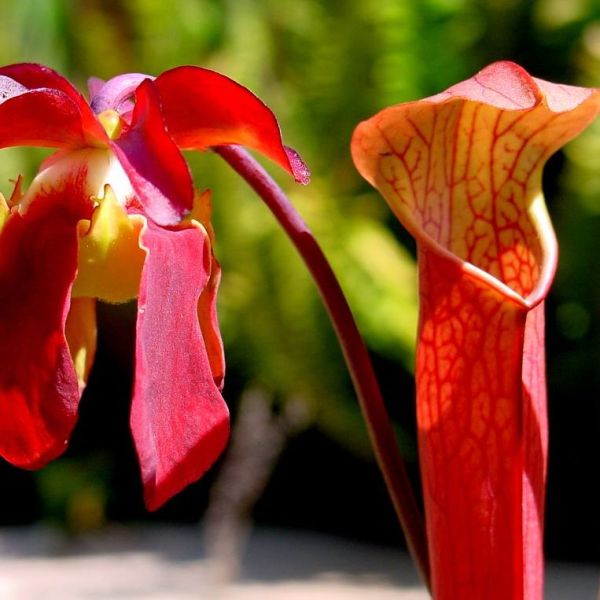Sarracenia Rubra Gulfensis Seeds (Red Pitcher Plant, Sweet Pitcher Plant)
Sarracenia Rubra Gulfensis Seeds (Red Pitcher Plant, Sweet Pitcher Plant)
This species generally occurs inland. Recommended for conservatory or sunny windowsill.

Delivery
All orders shipped with UPS Express.
Always free shipping for orders over US $250.
All orders are shipped with a UPS tracking number.
Returns
Items returned within 14 days of their original shipment date in same as new condition will be eligible for a full refund or store credit.
Refunds will be charged back to the original form of payment used for purchase.
Customer is responsible for shipping charges when making returns and shipping/handling fees of original purchase is non-refundable.
All sale items are final purchases.
Help
Give us a shout if you have any other questions and/or concerns.
Email: contact@domain.com
Phone: +1 (23) 456 789
Availability: In stock
SKU
Sarracenia Rubra Gulfensis
Sarracenia rubra gulfensis, the Red Pitcher Plant, or also named the Sweet Pitcher Plant, is probably the stockiest and most robust of all the Rubra subspecies. It produces pitchers up to 40 cm tall. The usual natural habitat includes boggy areas along creeks and ponds and on slight seepage slopes primarily in Northwest Florida. This species generally occurs inland. Recommended for conservatory or sunny windowsill.
Sarracenia rubra gulfensis flowers in April. The small, deep red flowers have only the slightest odor which is sweetish. The plant is dark red. The pitcher mouth is usually 2.4 to 3.5 cm wide and is dark red. The Gulf Sweet Pitcher develops dark red leaves by late Summer. The growing season is from May through November.
They trap their prey by offering them nectar to sip which is secreted around the lip of the plant and also at the base of the lid. Flying and crawling insects will find the nectar and if they take a wrong step, they will tumble into the pitcher. Once inside, they will find that retreat is impossible, due to short stiff hairs pointing downward. The inside of the pitchers are also very slippery, even to insects with the best traction. Once the insect reaches the bottom, it is dissolved by enzymes in the bottom of the pitcher and the nutrient value is absorbed by the plant.
Hardiness zone 8, (-10øC/15øF) in Winter. Though it requires 3-4 months of rest in cold temperatures, it maintains its leaves all through Winter. Cut off brown parts of trap. Protect from dry freezing wind. During their rest, continue to keep your plants in small amounts of standing water. This is necessary to prevent their soil from drying out. While your Sweet Pitcher is going through Winter dormancy outdoors, don't worry about brief temperature dips into 20's. If left outside during Winter, protect them from dry freezing wind during deep freezes by covering the plant with black plastic. Uncover the plant when the deep freeze and dry freezing wind is over.
Sweet Pitchers require nutrient-free soil that provides good drainage. Use a standard soil mixture of 50% peat moss and 50% perlite. Never use potting soil or fertilizer. Potting soil and fertilizer will kill your plant. Procure full sun during its growing season. During the growing season, grow your plant outside in full sun, with a minimum of 6 hours of direct sunlight for vigorous growth.
Keep the pot in standing water to keep the soil wet at all times. Never allow the soil to dry out completely. Water must be distilled or rain water because they do not tolerate city or hard water. It is a good idea to place a pie pan or large saucer, with about an inch of water in it, under the pot. Elevate the pot by placing pebbles under it so that the base of the pot is barely in contact with the water, not submerged; the growing medium must stay moist, but never soggy. This will keep the humidity around the plant higher and it will ensure that the plant has a constant source of moisture.
| Common name | Sweet Pitcher Plant |
|---|---|
| Species | Sarracenia rubra |
| Cultivar | gulfensis |
| Germination | The seeds require 6 weeks cold stratification before sowing, directly on the surface of your moist but not soaked soil mix. Once it's time to take the seeds out of cold stratification, cover the top of the pot with clear plastic so the humidity will remain high, place them in an area with real nice strong light and keep the temperature around 21øC/70øF, 27øC/80øF. When you see some tiny plants starting to sprout, slowly open the top of the pot, a little each day, so that the new seedlings don't go into shock from the humidity being lowered too quickly. After cold stratification, germination usually occurs in 1 to 3 months, but it can take longer, depending on their degree of unbroken dormancy, don't give up. |
| Scarification / Stratification | It creates a cold and moist environment for the seeds. This will break their dormancy. Place the seeds on top of a prepared soil mix. The pot is then placed into a ziplock bag with approximately an inch of water on the bottom of the bag. Close the bag shut and place it into the salad crisper compartment of your refrigerator. Make sure to check the seeds often. If fungus or mold appears treat it with a fungicide. |
| Price View | Price Range |

